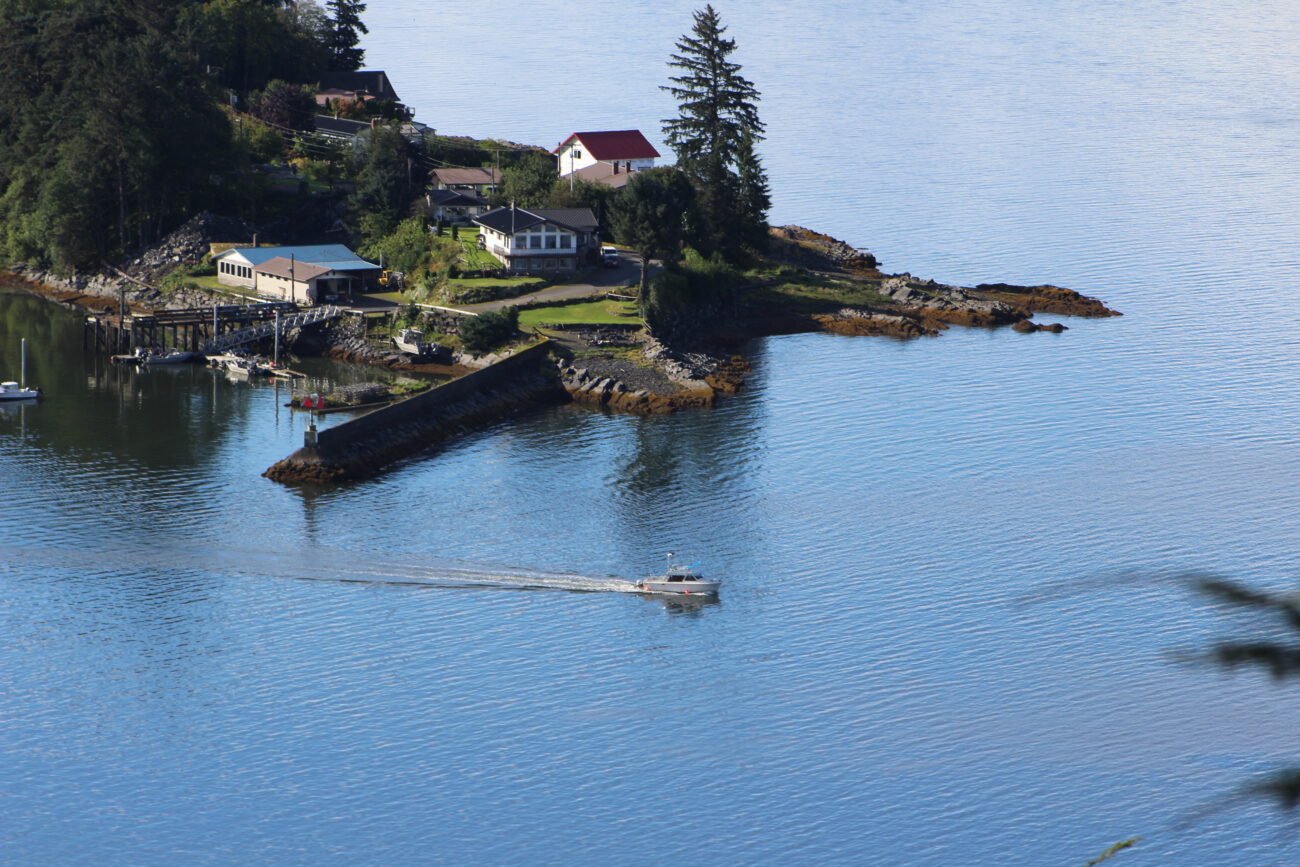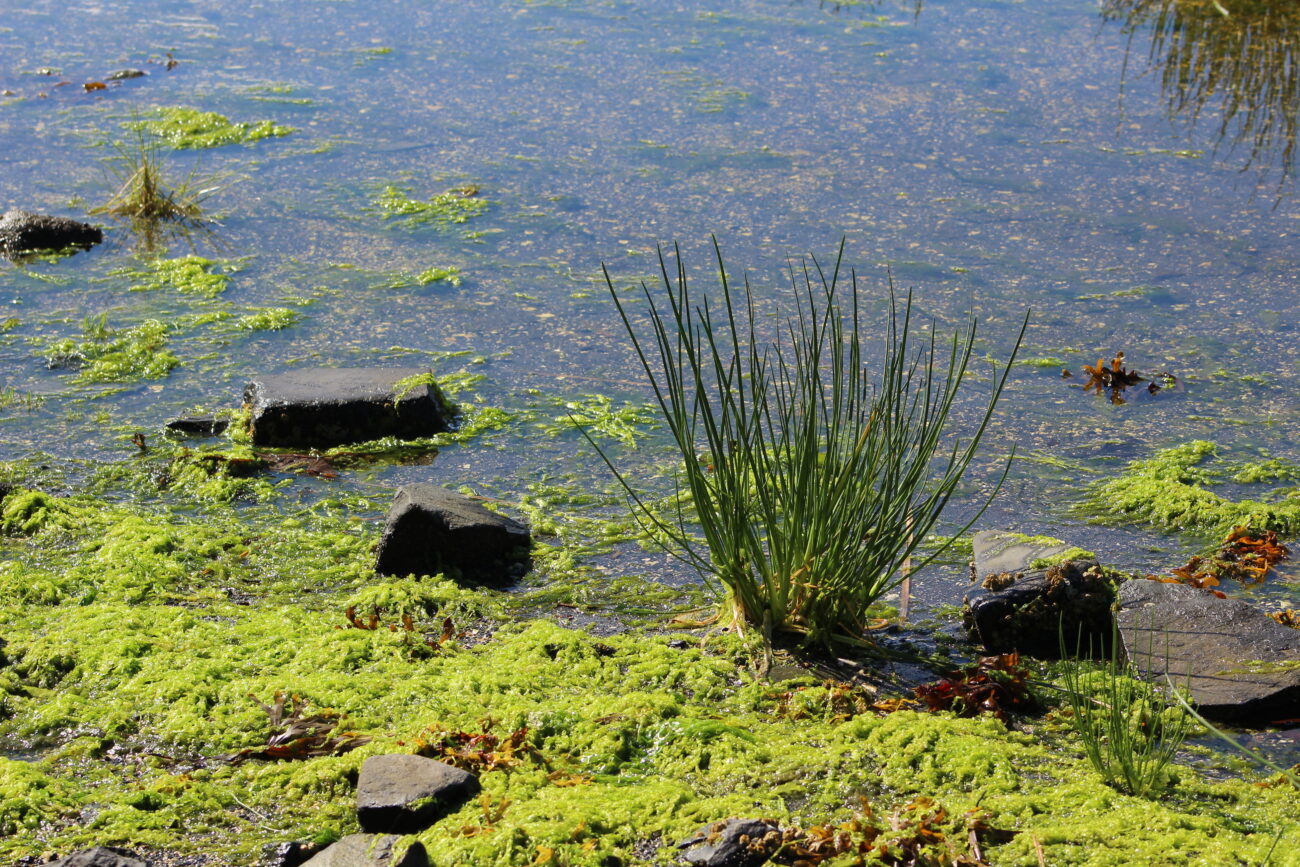
(Sage Smiley / KSTK)
Kelp grows naturally throughout Alaska’s waterways and is also grown and harvested by an expanding commercial seaweed industry. New research shows kelp has ecological benefits by absorbing pollution in the water.
Although slippery strands of kelp aren’t plants – they’re organisms called heterokonts, a kind of algae – they can pull carbon and nitrogen from their surrounding environment just like a forest on land.
New research from the University of Alaska Fairbanks funded by the Department of Energy’s ARPA-E grant shows some species of kelp may be especially effective at taking in nitrogen from the water. In other words, kelp may be able to help clean up polluted waterways.
“For some species, they are kind of like a sponge,” explains marine ecologist Schery Umanzor. She’s an assistant professor at UAF, and led the study. “So if there is a lot [of nitrogen], they can absorb a lot. But for some species, that sponge behavior is a little bit – it saturates faster. So it doesn’t matter if there is a lot, it can only absorb so much.”
Umanzor says it seems like ribbon kelp is more sensitive to nitrogen in the water, so it’s a better sponge, while sugar kelp is more slow and steady.
To gather data, Umanzor worked with kelp farmers who grew sugar and ribbon kelp side by side. Most of the samples came from a farm run by Seagrove Kelp in Doyle Bay off Prince of Wales Island. Some other samples were collected at more random intervals by a farm at Port Gravina in Prince William Sound, owned by the Native Conservancy. The farmers collected tissue samples and water samples every 30 days until the kelp was harvested, and then sent all the samples to Umanzor’s lab.
“By looking at the changes in water over time, I was able to relate this to the changes in nutrients in the [kelp] tissue to get an understanding how much they vary one versus the other one,” Umanzor explains.
Pulling carbon from water into kelp isn’t a new idea – and just this year, Gov. Mike Dunleavy proposed a law to update Alaska’s regulations to capitalize on carbon credit markets, where the carbon-collecting power of Alaska’s underground areas, forests and kelp could be sold to investors or organizations.
But Umanzor says her research indicates that the nitrogen-removing properties of kelp are the more compelling finding from the study.
“The difference between having a lot of carbon and a lot of nitrogen in the water is that carbon is not a contaminant, but nitrogen is,” Umanzor says. “A lot of nitrogen can produce algal blooms or PSP if you’re familiar – the blooms that cause shellfish poisoning – this is also driven by excess nutrients. So if we have a lot of kelp in the water, we potentially have better quality in the water column.”
Carbon sequestration – or the process of capturing and storing carbon from the atmosphere – and nitrogen removal also happen on very different timelines.

(Sage Smiley / KSTK)
“Sequestration is not something that can happen from one month to another. It has to happen in hundreds of years,” Umanzor says, “While nitrogen removal to avoid contamination is something that can happen literally in weeks or months.”
While nitrogen that might be absorbed by kelp wouldn’t be a contaminant for people, it’s often accompanied by other water-borne contaminants like fecal matter or heavy metals that could be harmful. Umanzor says there also needs to be research done and regulations put in place about whether kelp that might be used to help keep water clean could also be eaten.
But either way, the nitrogen-absorbing properties of kelp may be useful.
“Kelp grows naturally here because we have cold water. So maybe sites, for example, in Ketchikan that the DEC has labeled as polluted, maybe we can just take advantage that kelp grows naturally, and set some lines there and clean the water, teach people how to farm and just educate people on the benefits of having healthy kelp overall,” Umanzor muses.
There are plenty of potential directions to go with the knowledge that kelp can help lower nitrogen levels in the water. Umanzor says one could be a mutually beneficial relationship between kelp and salmon hatcheries.
“Perhaps we can leverage, to some extent, the nitrogen that is created in the salmon hatcheries and actually growth kelp it,” Umanzor says, “And then we will have a win-win: we will produce biomass from kelp that can then be processed to produce products, and we will be cleaning the water at the same time.”
That’s an exciting idea for people in the mariculture industry like Hannah Wilson, who is the development director of the Alaska Fisheries Development Foundation (AFDF). While coastal Alaska Native people have used seaweeds for centuries, commercial cultivation is a relatively new phenomenon.
She says there was a 200% increase in pounds of seaweed sold for 2020 and 2021. Wilson says some of that could be the pandemic-related market depression, but it’s still an upward trajectory.
Wilson says there are only about two-dozen seaweed permits in the state, less than half of which are actually operating right now, in addition to just over 20 farms that grow both shellfish and seaweed.
“In 2022, there was the highest number of applications that Fish & Game and the Alaska Department of Natural Resources have received in the last 20 years,” Wilson says, “And most of those were for seaweeds. So it seems like it’s growing really fast. People are really excited about it.”
“Currently,” she continues, “The industry really is focused on food markets. We have [companies like] Foraged & Found and Barnacle Foods that are creating these really high-end kind of boutique products, and I think there’s definitely interest in people growing at a larger scale, maybe for things more like animal feed – a less high-quality product, but a larger volume, just trying to kind of diversify that industry.”
While there aren’t very many commercial seaweed farms in Alaska right now, and the state is still working to set up regulatory frameworks and funding resources to help new farmers, the burgeoning industry is taking off.
Wilson says learning more about the potential ecological benefits of kelp farming is a way the industry can potentially diversify.
“When there’s really this focus on food product, I think it’s exciting to think about other ways that the industry can expand,” Wilson says, “And, obviously, there’s a lot of discussion going on, both in the state and around the world right now about kind of commodifying ecosystem services. So I think it’s great that this kind of gives people another avenue to explore as they’re starting their businesses and kind of see what focus they want to bring. Whether that’s focusing on carbon credits or something else, or growing seaweed for food.”
While the new research is promising, there are also still plenty of questions. Umanzor says this research is only the beginning.
“We only have an instantaneous photograph of a moment, in one place,” Umanzor says of the initial published research. “To be able to guarantee that the results are what they are, we need to increase our efforts in terms of region and maybe over the years. So replication is definitely something that we need to include, both in space and time. And that way, we will be able to tease apart which kelp species is better for cleaning the water column better: is it sugar kelp? Is it ribbon kelp? Is it bull kelp? We don’t know if they are all the same.”
Umanazor’s kelp study data is from the 2020-2021 season, and she says since then, she’s been working to analyze data from more sites.
“I just finished processing a repetition of this experiment, which included five farms: two in Southeast and three in Prince William Sound,” Umanzor says, “And it seems that the results hold. What’s interesting is that in some regions, the differences are more visible than in others. And I would like to understand why exactly – why you see clean results in one farm and not so cleanly in another.”
There’s a slew of funding heading to the state to support mariculture growth. A $49 million grant cluster from the federal government. More than $25 million for mariculture research from the Exxon Valdez Oil Spill Trustee Council. A $5 million mariculture matching grant from the state legislature.
And beyond that more than $75 million in funding for mariculture, Umanzor says her research also points to the value of kelp itself, whether it’s on a farm or growing wild.
“I think that we have, in Alaska, a great opportunity to actually tackle some common problems using smart solutions that are environmentally friendly,” Umanzor says.
And from her position – often on a boat – Umanzor says she sees many opportunities for kelp to come.
Get in touch with KSTK at news@kstk.org or (907) 874-2345.











